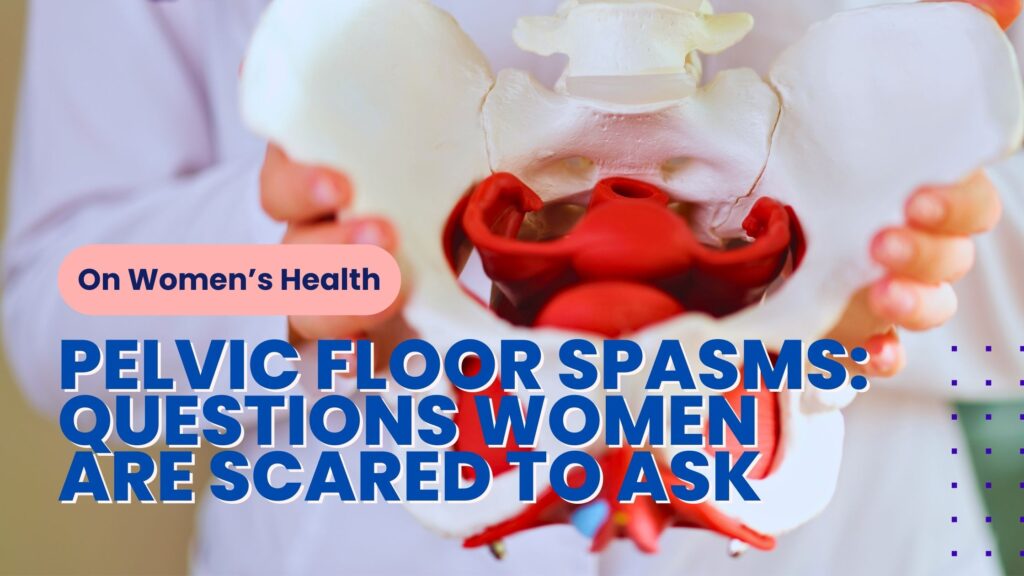Pelvic floor spasms, often called pelvic floor muscle spasms, are involuntary contractions of the muscles that support the pelvic organs. These spasms can lead to significant discomfort and disrupt daily activities. Despite their prevalence, many women hesitate to discuss this condition due to embarrassment or lack of information. This article aims to shed light on pelvic floor spasms, their causes, symptoms, and available treatments, particularly focusing on options in Arizona.
What Are Pelvic Floor Spasms?
The pelvic floor comprises a group of muscles and ligaments that form a supportive hammock across the pelvic opening. These muscles play a crucial role in controlling bladder and bowel functions, as well as sexual activity. When these muscles contract involuntarily, it results in pelvic floor spasms, leading to pain and discomfort.
What Causes Pelvic Floor Spasms?
Pelvic floor spasms can result from a variety of physical, medical, and psychological factors, often overlapping and contributing to a complex condition. Understanding these causes can help identify the root of the problem and guide effective treatment.
Childbirth
Childbirth is one of the most common contributors to pelvic floor dysfunction. During vaginal delivery, the pelvic floor muscles endure significant strain as they stretch to accommodate the baby. In some cases, these muscles may tear, weaken, or suffer nerve damage, leading to spasms. Prolonged labor or the use of tools like forceps can further increase the risk of trauma to the pelvic floor. These effects may not always manifest immediately but can cause chronic issues if left untreated.
Chronic Straining
Repeated straining places excessive pressure on the pelvic floor muscles, causing them to tighten and spasm over time. Conditions such as chronic constipation or irritable bowel syndrome (IBS) are primary culprits. Women who regularly engage in heavy lifting or high-intensity physical activities without proper core engagement may also experience overuse injuries to the pelvic floor muscles. Over time, this repetitive strain can lead to chronic tension and painful spasms.
Pelvic Surgery
Surgical interventions in the pelvic region, such as a hysterectomy, bladder repair, or endometriosis excision, can disrupt the natural function of the pelvic floor muscles. Scar tissue from surgery may limit muscle flexibility, while nerve irritation or damage during these procedures can lead to miscommunication between the brain and the muscles, resulting in involuntary spasms.
Infections
Pelvic infections, such as urinary tract infections (UTIs), bacterial vaginosis, or sexually transmitted infections, can cause inflammation and irritation of the surrounding tissues. This localized irritation often triggers the pelvic floor muscles to tighten reflexively, leading to spasms. Chronic or recurrent infections amplify this response, making the condition more difficult to manage.
Trauma
Physical trauma to the pelvic area, whether from an accident, fall, or blunt-force injury, can have a lasting impact on the pelvic floor. Injuries may result in bruising, scarring, or direct muscle damage, all of which increase the likelihood of spasms. Even after the initial injury heals, residual pain or compensatory muscle tension can perpetuate the cycle of discomfort.
Stress and Anxiety
Psychological factors like stress, anxiety, and depression are increasingly recognized as significant contributors to pelvic floor dysfunction. Stress can lead to the unconscious tightening of the pelvic floor muscles, similar to clenching a fist in response to tension. Over time, this habitual tightening can cause chronic muscle spasms. Additionally, anxiety may make people more sensitive to pain, making spasms more uncomfortable and starting a vicious cycle of pain and psychological distress.
Additional Contributing Factors
- Hormonal Changes: Hormonal fluctuations, particularly during menopause, can affect the elasticity and strength of pelvic tissues, potentially contributing to spasms. Reduced estrogen levels may lead to thinning of the vaginal walls and increased sensitivity of the pelvic muscles.
- Pelvic Misalignment: Misalignment of the pelvis or spine due to poor posture, scoliosis, or other musculoskeletal issues can increase tension in the pelvic floor. This imbalance often forces the muscles to compensate, resulting in spasms.
- Chronic Pain Syndromes: Conditions like fibromyalgia, interstitial cystitis, and vulvodynia often coexist with pelvic floor dysfunction. These syndromes amplify pain signals, making the pelvic floor muscles more susceptible to spasms.
- Sexual Trauma: Past experiences of sexual abuse or trauma can leave physical and emotional scars, both of which may contribute to pelvic floor hypertonicity. In such cases, therapy may be necessary to address the underlying causes.
- Overactive Bladder Syndrome (OAB): Women with OAB may unconsciously contract their pelvic muscles in response to urgency or frequent urination, leading to spasms over time.
By identifying and understanding these causes, individuals can work with a pelvic pain doctor to address the underlying issues contributing to pelvic floor spasms and regain control over their pelvic health.
Recognizing the Symptoms
Timely identification of pelvic floor spasms is crucial to initiating effective treatment and improving quality of life. The symptoms of this condition can vary widely, ranging from mild discomfort to debilitating pain, and may significantly interfere with daily activities. Below is an in-depth exploration of the common symptoms that may signal pelvic floor spasms.
Pelvic Pain
Pelvic pain is one of the hallmark symptoms of pelvic floor spasms. This pain may present as a dull, constant ache or as intermittent, sharp, stabbing sensations. Women often report that the discomfort is concentrated deep within the pelvic region and may worsen after prolonged sitting, standing, or engaging in activities that put pressure on the pelvic area. The pain can also fluctuate with the menstrual cycle, becoming more intense during certain phases.
Pain During Intercourse
Pain during or after sexual activity, also known as dyspareunia, is a common and distressing symptom of pelvic floor spasms. This discomfort arises from the involuntary tightening of the pelvic floor muscles, which can make penetration painful or impossible. Women experiencing this symptom may avoid intimacy, leading to emotional strain and difficulties in relationships. This symptom often requires a multidisciplinary approach involving both physical therapy and counseling.
Urinary Issues
Pelvic floor spasms can significantly affect bladder function, resulting in various urinary symptoms. These may include:
- Urgency: A persistent, sudden urge to urinate even when the bladder is not full.
- Frequency: Increased trips to the bathroom throughout the day or night.
- Painful Urination: A burning or stinging sensation while urinating, often mistaken for a urinary tract infection.
- Incomplete Emptying: A feeling that the bladder is not fully emptied, leading to repeated attempts to urinate. These symptoms can be misdiagnosed as overactive bladder or interstitial cystitis, highlighting the importance of accurate diagnosis.
Bowel Problems
The pelvic floor muscles play a critical role in regulating bowel movements. When these muscles spasm, they can disrupt normal bowel function, leading to:
- Constipation: Difficulty passing stool due to tightened muscles preventing proper relaxation.
- Pain During Bowel Movements: Sharp or cramping pain when trying to defecate, often accompanied by straining.
- Incomplete Evacuation: A sensation that the bowels are not fully emptied, leading to discomfort and bloating. In severe cases, chronic constipation caused by pelvic floor spasms may lead to the development of hemorrhoids or anal fissures.
Lower Back Pain
Lower back pain is another common symptom linked to pelvic floor spasms. The pelvic floor muscles are closely connected to the lower back and sacroiliac joints, and dysfunction in one area can impact the other. Women with pelvic floor spasms often describe a dull, nagging pain that radiates from the pelvis to the lower back, especially after prolonged periods of sitting or physical exertion. This symptom is frequently overlooked, as it is often attributed to general musculoskeletal issues.
Other Possible Symptoms
- Abdominal Discomfort: A sense of pressure or heaviness in the lower abdomen, often mistaken for gastrointestinal issues.
- Pain with Certain Movements: Actions such as bending, lifting, or even walking can exacerbate muscle tension and trigger spasms.
- Unexplained Vaginal or Rectal Pain: Sharp or throbbing sensations in the vaginal or rectal area without an apparent cause.
- Postural Issues: Chronic pelvic pain can lead to compensatory changes in posture, resulting in additional strain on the pelvic and surrounding muscles.
- Emotional and Psychological Impact: Chronic symptoms can lead to anxiety, depression, and social withdrawal, further complicating the overall condition.
Seeking Diagnosis and Treatment
If you experience any of these symptoms persistently or if they worsen over time, it is crucial to consult a pelvic pain doctor. Early diagnosis and treatment are essential to prevent further complications and improve overall quality of life. A pelvic pain specialist can accurately identify the root cause of these symptoms and tailor a treatment plan to address your specific needs.
Diagnosis: When to See a Pelvic Pain Doctor
These specialists are trained to diagnose and treat conditions related to pelvic floor dysfunction. During the consultation, the doctor may:
- Medical History Review: Discuss your symptoms, medical history, and lifestyle.
- Physical Examination: Assess the pelvic muscles for tenderness or tightness.
- Diagnostic Tests: Recommend imaging studies or other tests to rule out other conditions.
Best Pelvic Pain Treatment Clinic in Arizona
Arizona offers a range of treatment options for pelvic floor spasms:
- Physical Therapy: Specialized pelvic floor physical therapy focuses on relaxing and strengthening the pelvic muscles. Techniques may include manual therapy, biofeedback, and exercises.
- Medications: Muscle relaxants or pain relievers can alleviate symptoms.
- Injections: Trigger point injections can provide relief by targeting specific muscle areas.
- Lifestyle Modifications: Stress management, dietary changes, and regular exercise can improve symptoms.
- Surgical Interventions: In severe cases, surgery may be considered to address underlying issues.
For those experiencing persistent pelvic pain, the Arizona Center for Chronic Pelvic Pain (AZCCPP) offers comprehensive care. We provide multidisciplinary approaches, including:
- Pain Management Specialists: Doctors specializing in chronic pain conditions.
- Physical Therapists: Experts in pelvic floor rehabilitation.
- Counselors: Professionals addressing the psychological aspects of chronic pain.
Dr. Michael Hibner, a renowned Female Pelvic Medicine & Reconstructive Surgeon and AZCCPP owner emphasizes early intervention’s importance. He states, “Addressing pelvic floor spasms promptly can significantly improve a woman’s quality of life.” Dr. Hibner also notes, “A multidisciplinary approach ensures that all aspects of the condition are treated effectively.”
READ MORE: Endometriosis: Top 10 FAQs You Need to Know
Conclusion: Taking Charge of Your Pelvic Health
Pelvic floor spasms are a common yet often overlooked condition that can significantly impact a woman’s life. Understanding the causes, recognizing the symptoms, and seeking appropriate treatment are vital steps toward recovery. Arizona offers a wealth of resources, including specialized pelvic pain doctors and chronic pain clinics, to support women in their journey toward better pelvic health.
Take the Next Step Toward Pelvic Pain Relief

If you’re experiencing pelvic floor spasms or related symptoms, don’t hesitate to seek help. The Arizona Center for Chronic Pelvic Pain (AZCCPP) specializes in diagnosing and treating pelvic floor disorders. Our team, under the direction of Dr. Michael Hibner, is devoted to offering you individualized care that is responsive to your needs.
Why Choose AZCCPP?
- Expertise: Dr. Hibner brings extensive experience in pelvic medicine and reconstructive surgery.
- Comprehensive Care: We offer a multidisciplinary approach, addressing all aspects of your condition.
- Patient-Centered Approach: Your comfort and well-being are our top priorities.
Contact Us Today
Take control of your pelvic health by scheduling a consultation with our team. Visit our website at AZCCPP or call us at (602) 265-1112 or [email protected] to book an appointment. Let us help you on your path to recovery and improved quality of life. Also check out AZCCPP on YouTube for more questions that need answers with Dr. Michael Hibner.

